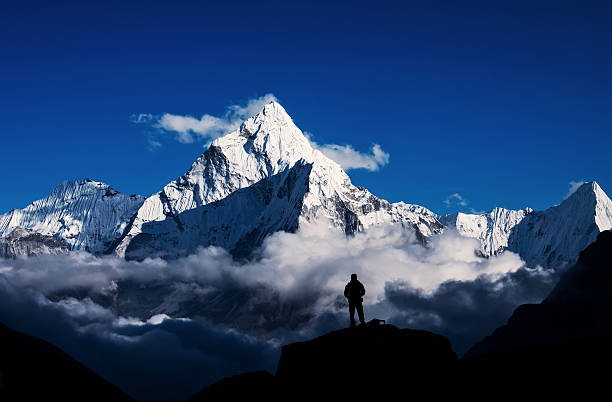Uncovering the Mysteries of Rainbow Valley on Mount Everest

Rainbow Valley Mt Everest is a mysterious and mystical location tucked away in the breathtaking Himalayas. Adventurers and lovers of the outdoors have been enthralled by this hidden treasure and drawn to its seductive mysteries.
We set out on a quest to solve the riddles of this remarkable location and reveal the sinister truths that reside behind its colorful exterior in this piece.
How Was the Name of Rainbow Valley Mt Everest’s Derived?
Situated beneath the northern ridge of Rainbow Valley Mount Everest, derives its fascinating name from a melancholic but breathtaking occurrence that happens in this high-altitude region. This name comes from the valley’s colorful look, which was caused by the presence of many dead climbers and the debris from their trips.
Climbers who have perished while trying to reach the summit of Mount Everest are left behind in this barren area at elevations above 8000 meters. Their bright tents, jackets, and other gear make for a macabre yet remarkably colorful picture. Rainbow Valley got its name from the bright clothes and gear that were left all over the place.
Rainbow Valley’s Geological Formations and Distinctive Scenery of Mount Everest
The “Death Zone” of Mount Everest, which is defined as elevations over 8000 meters where oxygen concentrations are dangerously low and survival is exceedingly difficult, is where Rainbow Valley is located. This area has tough, unforgiving terrain with small, steep paths that can only support one climber at a time.
Climbers who fail the trials of Everest frequently stay in the Death Zone, becoming an indelible part of Rainbow Valley’s spooky scenery because of the hazardous conditions and thin air.
The combination of hard natural circumstances that preserve climbers’ remains for extended periods and human components, such as colorful clothing and equipment left behind, has resulted in the valley’s unique scenery. The depths of the cold, combined with their limited ability to decompose, have left the bodies of the dead surprisingly preserved.
Scientific Justifications for the Mt. Everest Rainbow Valley’s Rainbow Effect
The rainbow-like appearance of the valley is not the product of any paranormal activity, but rather of the array of vibrant clothes and equipment that climbers choose to wear. A visual extravaganza akin to a rainbow is created by the dramatic contrast between the brilliant jackets and accessories and the austere, frigid surroundings.
The vivid and varied spectrum of colors seen in the valley is also enhanced by the use of various materials and colors in the tents, oxygen tanks, and jackets—such as blue, red, orange, and green. Even though the conditions are significantly more dire, the arrangement of these hues and materials can, from a distance, approximate the rainbow’s color spectrum.
Where on Everest Is The Rainbow Valley?
Below the northern slope of Mount Everest sits the area known as the “Death Zone,” which is home to the menacing Death Zone, perched at mind-boggling altitudes surpassing 8000 meters (26,247 feet) on the merciless expanse of the formidable mountain.
It’s a place of eerily low oxygen, ruthless weather, and unstable terrain; it’s Everest’s mysterious mystery, the height of dangers and obstacles. A pitch-black chasm where several brave climbers have met their tragic end at the hands of harsh weather and a brutal shortage of oxygen necessary for survival.
This high-altitude area is frequently home to the bodies of people who have died trying to reach the top. The Rainbow Valley is a vivid and eerie place created by the colorful apparel, equipment, and gear of these climbers.
A climber’s chances of success and survival in the Death Zone are greatly increased by being well-prepared, physically fit, and acclimated to the altitude. Reaching the Death Zone is a crucial point in any Everest expedition.
What’s the reason behind the corpse pile in Rainbow Valley Everest?
The “Death Zone,” which is situated above 8000 meters (26,247 feet) on the mountain, presents difficult and dangerous conditions, which is why the bodies are piling up in Rainbow Valley on Everest. This dismal occurrence is caused by some factors:
Challenges in Recuperation
Any attempt to rescue someone from the Death Zone is met with an enormous struggle due to its high altitude, bone-chilling cold, and merciless gales. The work of recovering the bodies of fallen climbers from this dangerous area becomes difficult and expensive.
The dead are left stranded in their icy resting place as helicopter rescues are practically impossible due to the severe weather and strong winds. Even fearless climbers, well informed of the dangers, are reluctant to set out on dangerous missions to retrieve the fallen, as the Death Zone is merciless and could take more lives in the process of pursuing such noble but dangerous goals.
Tight and Perilous Pathways
There can only be one climber at a time via the Death Zone because of its treacherous and tight pathways. The bodies of climbers who pass away from the severe weather may still be visible on the trail. Often forced off the trail, the dead end up resting in places like Rainbow Valley as other climbers carry on with their ascent or descent.
High Death Toll
The majority of deaths on Rainbow Valley Mount Everest happen in the Death Zone. Climbers in the Death Zone face an unrelenting assault of extreme difficulties in addition to dangerously low oxygen levels, harsh weather, and extreme fatigue. Sadly, the death toll in this dangerous area outweighs that of other mountainous areas, leading to an eerie build-up of corpses over time in the eerie area known as Rainbow Valley.
Expensive Recoveries
Recovering bodies from high elevations is an expensive operation that calls for a large team and specific tools. Many people are deterred from trying recovery efforts by the exorbitant expense and logistical challenges, which causes a build-up of bodies in the area.
What Befalls Those Who Pass Away In The Rainbow Valley Of Mount Everest?
The bodies of those who pass away in Everest’s Rainbow Valley are left behind. It is generally thought that recovering bodies from the Death Zone’s high altitude and hazardous terrain is too unsafe or impracticable to do. Because of this, the dead climbers who perish on their Everest treks could spend years or perhaps decades in Rainbow Valley. The following is the fate of deceased individuals in the Rainbow Valley Mt Everest:
Remains to Stay in Position
Climbers who have died in the Death Zone frequently leave their bodies where they fell. The bodies are preserved exceptionally well by harsh circumstances, which include below-freezing temperatures and restricted decomposition because of the cold. The relics might therefore stay in the valley for a long time.
Haunting Presence
Rainbow Valley is home to an eerie and moving sight, created by the colorful clothing, equipment, and gear that climbers who have passed away have left behind. The valley stands as a somber reminder of the dangers and costs incurred by individuals who endeavored to climb Mount Everest.
Deterioration with time
Although the intense cold can help preserve the remains to some extent, the unforgiving environment may eventually lead to deterioration. The remnants may be dispersed or displaced by avalanches and other natural disasters.
Tributaries and Honor
A few climbers who recognize the difficulties and perils of Everest may stop by Rainbow Valley to pay their respects to the departed. Markers or memorials may occasionally be erected in memory of the climbers who lost their lives.
Popular Stories about the Rainbow Valley on Mount Everest
Everest in Green Boots
“Green Boots” is a well-known and terrifying tale connected to Rainbow Valley Mt Everest. It tells the story of a dead climber whose body has turned into a notable and iconic landmark in the Death Zone. The climber’s green boots can be used to identify their body, which is found within a small cave on Everest’s northeast ridge.
Though it is still up for debate and mystery, Green Boots’ identity is thought to be that of Tsewang Samanla, an Indian climber who vanished during the 1996 Everest accident. A well-known landmark for climbers making their way to the top, Green Boots’ image serves as a chilling reminder of the dangers associated with the sport.
Everest’s Sleeping Beauty – Francys Arsentiev
In 1998 American climber Francys Arsentiev set out on a mission to reach the peak of Everest. Even though she made it to the summit without the need for extra oxygen, she had trouble going down. The harsh weather and tiredness that beset Francis and her husband, Sergei Arsentiev, left them stuck at high heights.
Sergei bravely attempted to scale the mountain again to save his wife, but he was unable to do so. Francys was nicknamed “Sleeping Beauty” because of her serene demeanor despite her terrible circumstances when she was discovered by a rescue squad, barely alive and clinging to life.
Sadly, Francys Arsentiev died on the mountain from the challenges of getting her out of the dangerous, high-altitude environment. Her body stayed in the Rainbow Valley of Mount Everest, a moving representation of the difficulties experienced by Everest climbers.
Scott Fischer
American mountaineer and guide Scott Fischer was a member of the tragic 1996 Everest trip that resulted in several deaths. Fischer led the Mountain Madness guiding firm and was a well-known and accomplished climber. Sadly, he and his clients encountered several difficulties both climbing and descending.
Fischer died on the mountain from tiredness and the hazardous conditions. His body stayed in the Death Zone, serving as a grim reminder of the inherent dangers that even experienced climbers on Everest must deal with. The tale of Fischer and the events of the 1996 catastrophe were eventually documented in books and documentaries, contributing to Mt. Everest Rainbow Valley’s legendary reputation.
In summary
As our voyage through the mysterious Rainbow Valley Mt Everest comes to an end, we discover that the experiences and insights we have obtained have permanently altered who we are. This place is genuinely extraordinary because of the exquisite tapestry of nature, culture, and human spirit that has been revealed as the hidden dark secrets have come to light.
We depart the area with a greater appreciation for responsible exploration and the knowledge that Rainbow Valley will always hold a special place in our hearts, encouraging us to travel farther, dream bigger dreams, and protect the natural beauties of the globe.
For more blogs click here



